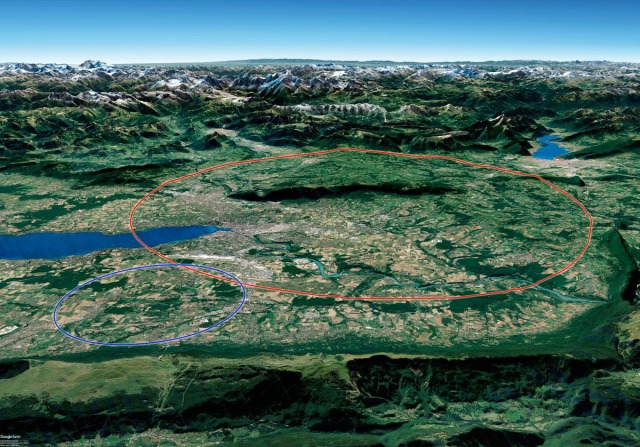Future Circular Collider (FCC)
"Today, the FCC international collaboration submitted for publication the Conceptual Design Report for a post-LHC circular collider at CERN."

The Future Circular Collider (FCC) international collaboration submitted today for publication the Conceptual Design Report (CDR) for a post-LHC circular accelerator at CERN. This four-volume document presents the different options for the large circular collider of the future. It showcases the great physics opportunities offered by machines of unprecedented energy and intensity and describes the technical challenges, cost and schedule for realisation.
LIP was part of this effort, which involved more than 1300 contributors from 150 universities, research institutes and industrial partners and counted on the support of the European Comission. Among others, we highlight the contribution of the LIP Phenomenology Group to the section "FCC Physics opportunities".
The particle physics community is updating the European Strategy for Particle Physics, outlining the future of the discipline beyond the horizon of the LHC.The new CDR contributes to the European Strategy. The possibility of a future circular collider will be examined during the strategy process, together with the other post-LHC collider option at CERN, the CLIC linear collider. The large particle physics projects are long races. It is thus important to define the research and developments paths to take in the coming years, ultimately with a view to building the particle accelerator that will succeed the LHC
The FCC study started in 2014 and stems directly from the previous update of the European Strategy, approved in May 2013, which recommended that design and feasibility studies be conducted in order for Europe “to be in a position to propose an ambitious post-LHC accelerator project at CERN by the time of the next Strategy update”. The possibility of a future circular collider will be examined during the strategy process, together with the other post-LHC collider option at CERN, the CLIC linear collider.
“The FCC ultimate goal is to provide a 100-km superconducting proton accelerator ring, with an energy of up to 100 TeV, meaning an order of magnitude more powerful than the LHC”, said CERN Director for Accelerators and Technology, Frédérick Bordry. A 90 to 365 GeV electron-positron machine with high luminosity could be a first step. Such a collider would be a very powerful “Higgs factory”, making it possible to detect new, rare processes and measure the known particles with precisions never achieved before. These precise measurements would provide great sensitivity to possible tiny deviations from the Standard Model expectations, which would be a sign of new physics. The search for new physics, for which a future circular collider would have a vast discovery potential, is therefore of paramount importance to making significant progress in our understanding of the universe. “The FCC timeline foresees starting with an electron-positron machine, just as LEP preceded the LHC. This would enable a rich programme to benefit the particle physics community throughout the twenty-first century”, Bordry adds.
“The FCC conceptual design report is a remarkable accomplishment. It shows the tremendous potential of the FCC to improve our knowledge of fundamental physics and to advance many technologies with a broad impact on society”, said CERN Director-General Fabiola Gianotti.
The cost of a large circular electron-positron collider would be in the 9000-million-euro range, including 5000 million euros for the civil engineering work for a 100-kilometre tunnel. This collider would serve the worldwide physics community for 15 to 20 years. The physics programme could start by 2040 at the end of the High-Luminosity LHC. The cost estimate for a superconducting proton machine that would afterwards use the same tunnel is around 15 000 million euros. This machine could start operation in the late 2050s. A future circular collider would offer extraordinary opportunities for industry, helping to push the limits of technology further. It would also provide exceptional training for a new generation of researchers and engineers.



